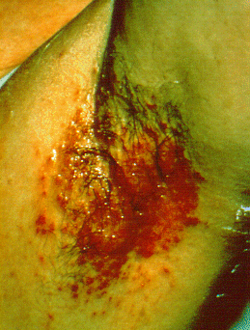Streptococcal intertrigo

Editor-In-Chief: Prab R Tumpati, MD
Obesity, Sleep & Internal medicine
Founder, WikiMD Wellnesspedia &
W8MD medical weight loss NYC and sleep center NYC
| Streptococcal intertrigo | |
|---|---|

| |
| Synonyms | |
| Pronounce | N/A |
| Specialty | Dermatology |
| Symptoms | Erythema, maceration, foul odor |
| Complications | |
| Onset | |
| Duration | |
| Types | |
| Causes | Group A Streptococcus |
| Risks | |
| Diagnosis | Clinical diagnosis, bacterial culture |
| Differential diagnosis | Candidiasis, contact dermatitis, inverse psoriasis |
| Prevention | |
| Treatment | Topical antibiotics, oral antibiotics |
| Medication | |
| Prognosis | |
| Frequency | |
| Deaths | |
Streptococcal intertrigo is a skin condition characterized by inflammation and infection of the skin folds, primarily caused by Streptococcus bacteria. This condition is most commonly observed in infants and young children, but it can also affect adults, particularly those with compromised immune systems or underlying skin conditions.
Pathophysiology[edit]
Streptococcal intertrigo occurs when the skin folds become moist and macerated, creating an ideal environment for bacterial growth. The Streptococcus bacteria, which are part of the normal skin flora, can overgrow in these conditions, leading to infection. The most common species involved is Streptococcus pyogenes, a Group A streptococcus.
Clinical Presentation[edit]
Patients with streptococcal intertrigo typically present with:
- Erythematous, moist patches in the skin folds
- Foul odor
- Pain and tenderness in the affected area
- Possible exudate or crusting
Common sites include the axilla, inguinal region, and neck folds. In infants, the diaper area is frequently affected.
Diagnosis[edit]
Diagnosis of streptococcal intertrigo is primarily clinical, based on the appearance of the lesions and the location. A bacterial culture can be performed to confirm the presence of Streptococcus species. Differential diagnosis includes candidal intertrigo, seborrheic dermatitis, and psoriasis.
Treatment[edit]
The mainstay of treatment for streptococcal intertrigo involves:
- Keeping the affected area clean and dry
- Topical or oral antibiotics, such as penicillin or amoxicillin, to eradicate the bacterial infection
- Use of barrier creams to protect the skin
In severe cases, systemic antibiotics may be necessary. It is also important to address any underlying conditions that may predispose the patient to intertrigo, such as obesity or diabetes mellitus.
Prevention[edit]
Preventive measures include:
- Maintaining good hygiene
- Keeping skin folds dry
- Using absorbent powders or barrier creams
- Wearing loose-fitting clothing to reduce friction
See Also[edit]
Ad. Transform your life with W8MD's Budget GLP-1 injections from $75


W8MD offers a medical weight loss program to lose weight in Philadelphia. Our physician-supervised medical weight loss provides:
- Weight loss injections in NYC (generic and brand names):
- Zepbound / Mounjaro, Wegovy / Ozempic, Saxenda
- Most insurances accepted or discounted self-pay rates. We will obtain insurance prior authorizations if needed.
- Generic GLP1 weight loss injections from $75 for the starting dose.
- Also offer prescription weight loss medications including Phentermine, Qsymia, Diethylpropion, Contrave etc.
NYC weight loss doctor appointmentsNYC weight loss doctor appointments
Start your NYC weight loss journey today at our NYC medical weight loss and Philadelphia medical weight loss clinics.
- Call 718-946-5500 to lose weight in NYC or for medical weight loss in Philadelphia 215-676-2334.
- Tags:NYC medical weight loss, Philadelphia lose weight Zepbound NYC, Budget GLP1 weight loss injections, Wegovy Philadelphia, Wegovy NYC, Philadelphia medical weight loss, Brookly weight loss and Wegovy NYC
|
WikiMD's Wellness Encyclopedia |
| Let Food Be Thy Medicine Medicine Thy Food - Hippocrates |
Medical Disclaimer: WikiMD is not a substitute for professional medical advice. The information on WikiMD is provided as an information resource only, may be incorrect, outdated or misleading, and is not to be used or relied on for any diagnostic or treatment purposes. Please consult your health care provider before making any healthcare decisions or for guidance about a specific medical condition. WikiMD expressly disclaims responsibility, and shall have no liability, for any damages, loss, injury, or liability whatsoever suffered as a result of your reliance on the information contained in this site. By visiting this site you agree to the foregoing terms and conditions, which may from time to time be changed or supplemented by WikiMD. If you do not agree to the foregoing terms and conditions, you should not enter or use this site. See full disclaimer.
Credits:Most images are courtesy of Wikimedia commons, and templates, categories Wikipedia, licensed under CC BY SA or similar.
Translate this page: - East Asian
中文,
日本,
한국어,
South Asian
हिन्दी,
தமிழ்,
తెలుగు,
Urdu,
ಕನ್ನಡ,
Southeast Asian
Indonesian,
Vietnamese,
Thai,
မြန်မာဘာသာ,
বাংলা
European
español,
Deutsch,
français,
Greek,
português do Brasil,
polski,
română,
русский,
Nederlands,
norsk,
svenska,
suomi,
Italian
Middle Eastern & African
عربى,
Turkish,
Persian,
Hebrew,
Afrikaans,
isiZulu,
Kiswahili,
Other
Bulgarian,
Hungarian,
Czech,
Swedish,
മലയാളം,
मराठी,
ਪੰਜਾਬੀ,
ગુજરાતી,
Portuguese,
Ukrainian